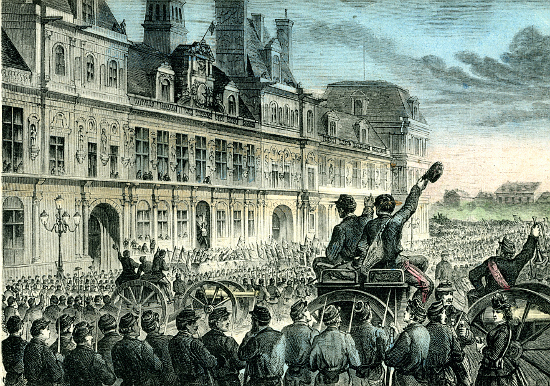MAIS ABSOLUMENT!
Night-time cruises show the legendary culture in a spectacular way...
Uncredited photos are mine unless otherwise said.
Some add to it with superb cuisine.
While noticing what is usually skipped reveals that culture differently:
An American who has lived in Paris for decades, I'm a passionate historian, tour guide and was a member of the Office of Tourism for seven years. For years I accepted the usual view of the city as a kind of museum, with a past that was fascinating but a present that was rather banal. Gradually I realized that the accepted account of the past is misleading and that the the vitality of the present is not understood.
Its summary: The usual presentation sometimes presents the elites' culture superbly, as does the boat trip just mentioned and the historical museum's suite of reconstructed salons. But its take on the insurrections that began in Paris, could rock Europe and contributed to making the modern world is appalling: That museum even turns deadly barricades into a game for kids.
# # #
TRAILERS
I.
CREATIVITY MOVES TO THE OUTSKIRTS
As brands and mass production dominate the center, outlying areas are where major cultural initiatives are launched and experiments tried (for examples, please click here, here and here).
La Goutte d'Or, a part-African neighborhood at the city's northern edge, embodies newcomer energy. Its effervescent small-scale couture industry is part of a sociable art that comes from Africa: physical “looks” as compositions to communicate.
Seen on rue Doudeauville, "Main Street"
That energy explains the barbershops and beauty salons, the stores selling the bright prints associated with Africa, wigs, beauty products (...) and young tailors behind their sewing machines.
- Barbershop signs propose innumerable styles. Their origin: signs in African markets...
Sign at the Abidjan's Treichville market, 1973. Notice the "Kennedy" cut.
- Soccer players adopted them to be identified on television during the 2014 World Cup and they immediately spread world wide.
  |
Mathieu Debuchy and Bakari Sagna, Équipe de France / zoom |
- Black barbershops remain the point of departure for styles in cuts, beards and moustaches, the much rarer hairdressers in other neighborhoods timidly following.
Bouno coiffure, 51 rue de la Goutte d'Or, 18th
"Art must reveal a philosophy. Otherwise it is just decoration," an art critic told me. The coiffures, beards and costumes express an upbeat affirmation of individual uniqueness, and the signs a context of a homogenous, supportive community.
Traditional shops reflect that philosophy. How they present their wares does not matter, since clients come because they know the vendors and may stay to keep them company. Good humor is omnipresent — for an example of kindness when I least expected it, please click.
People support each other: that’s key to surviving in an often harsh European world, and a lesson that in our capitalist system we might ponder.
II.
PARIS'S 19TH-CENTURY INSURRECTIONS
HELPED SHAPE OUR WORLD,
BUT LITTLE IS SAID ABOUT THEM
- Many people think the figures in an iconic painting are storming the Bastille (in 1789)...
La Liberté guide le people by Eugene Delacroix, 1830-1831 (cropped) / zoom
But in fact, the Revolution of 1830 inspired the work. Its three days of combat finished what the French Revolution had begun: eliminating nobles' power, which let capitalism take wing. That is almost never mentioned. Capitalism isn't either.
The last and most tragic upheaval led to the Paris Commune, when inexperienced young leaders whom humble people backed ran City Hall from March to May 1871.
Proclamation de la Commune le 26 mars 1871, anonymous engraving / zoom
In spite of war with the national government, a siege and the flight of most seasoned administrators, they kept the continent's largest city (one million residents) running. They also sketched out a vision for a genuinely democratic society under workers' control.
"They failed because of their great decency" said Marx of these idealists. They did not touch the gold the fleeing government left, their nurses tended the wounded on both sides and they used scarce revenues to succor widows whose men had died fighting them.
Their merciless repression announces future genocides.
 |
| Un Peloton d'exécution [firing squad] versaillais pendant la Semaine sanglante [Bloody Week] by V. Sarday, "Friends of the Paris Commune" / zoom ("Versaillais:" The regular government had fled to Versailles.) |
The painting made a generation later is based on illustrations of the time and adversaries' grudging respect.
# # #
The sequel, History from Fresh Perspectives, shows history as the study of change set in its economic context, and suggests a reason why that and most of what is unearthed here is left out.
# # #
This is a "blook,"a book that makes its points briskly through headlines and pictures, as a blog can.
It includes drawings by Harald Wolff. Like the vast majority of Parisian artists since the 1960's he is foreign (German), and lives not in the places associated with artists (Saint-Germain, Montmartre, Montparnasse) but in a plebeian suburb (Montreuil) where rents are lower. So he is part of the ignored reality that these pages describe.
The index, under the menu on the right, gives immediate access to the main ideas.
Contents lets you click directly into specific pages.
Epilogues suggests their wider relevance.
There's space for comments at the end of each page: I would very much like to know what you think. Political remarks are welcome.
* * *
Next,





.jpg)

_-_WGA6178.jpg)






